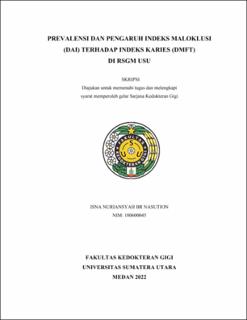Prevalensi dan Pengaruh Indeks Maloklusi (DAI) Terhadap Indeks Karies (DMFT) di RSGM USU
Prevalence and Influence of Malocclusion Index (DAI) on Caries Index (DMFT) at USU Dental and Oral Hospital

Date
2022Author
Nasution, Isna Nuriansyah Br
Advisor(s)
Nugroho, Teguh Aryo
Metadata
Show full item recordAbstract
Malocclusion, a deviation from the accepted standard occlusion, is a common
dental health issue that, if left untreated, can lead to various oral diseases, including
dental caries. Irregularly aligned teeth can make oral hygiene maintenance more
difficult, increasing plaque accumulation and the risk of caries development. The
Dental Aesthetic Index (DAI) is one of the indices used to assess malocclusion and
determine the need for orthodontic treatment based on its severity. This study aims to
determine the prevalence and the influence of the malocclusion index (DAI) on the
caries index (DMFT) at USU Dental and Oral Hospital. This analytic study used a
cross-sectional design involving 63 study models and patients’ medical records prior
to orthodontic treatment who met the inclusion and exclusion criteria. Results showed
that in males, the prevalence of mild malocclusion was 16.1%, moderate 19.4%, severe
25.8%, and very severe 38.7%; while in females, mild malocclusion was 18.8%,
moderate 25.0%, severe 31.3%, and very severe 25.0%. The average DMFT score in
males with mild malocclusion was 1.40±1.52, moderate 1.83±1.33, severe 4.13±1.81,
and very severe 4.33±1.67. In females, the DMFT scores were 1.17±1.94 (mild),
3.00±1.51 (moderate), 4.70±2.00 (severe), and 4.63±1.60 (very severe). Based on the
One-way ANOVA test, the result was p = 0.002, indicating a significant correlation
between the malocclusion index (DAI) and the caries index (DMFT) in both males and
females aged 17–25 years at USU Dental and Oral Hospital.
Collections
- Undergraduate Theses [1900]
